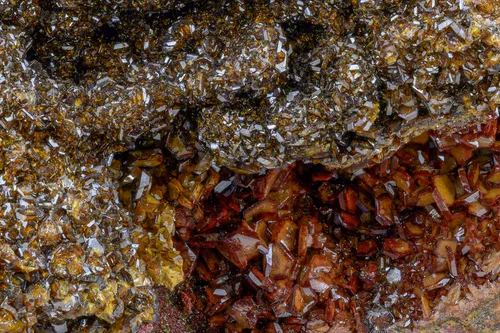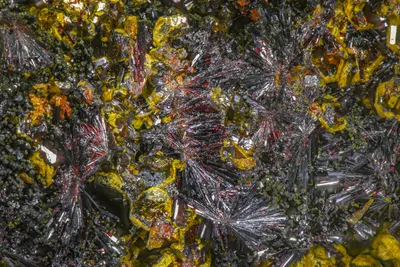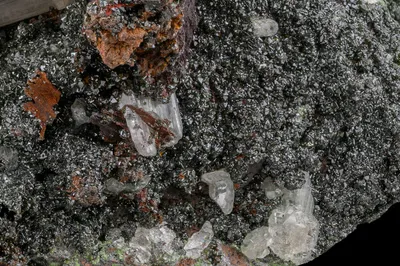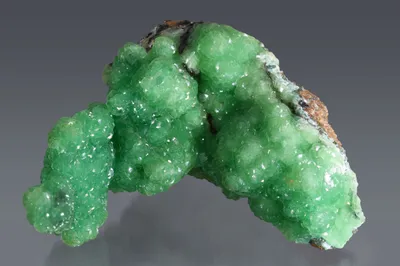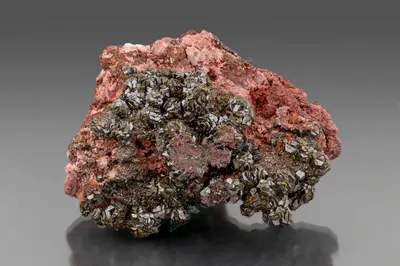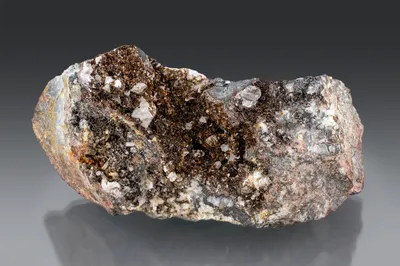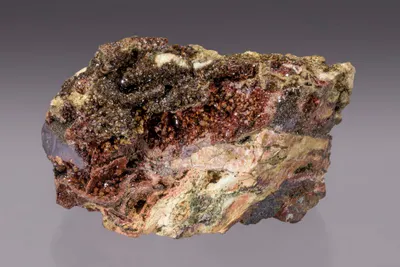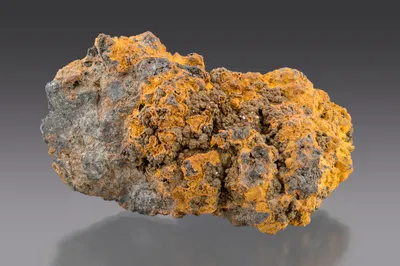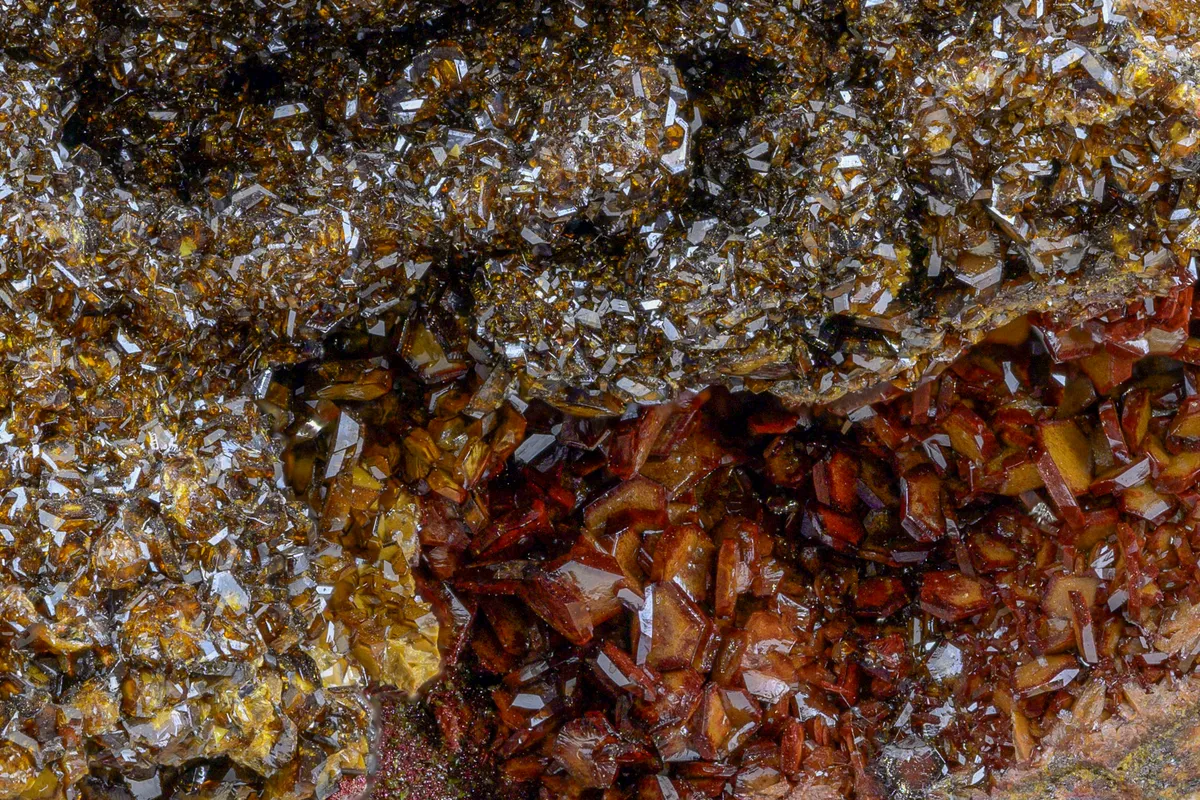
Image Credit: Malcolm Southwood
Mineral Species
Beudantite
Type Locality
No
Composition
PbFe3+3(As0.5S0.5O4)2(OH)6
Crystal System
Trigonal
Status at Tsumeb
Confirmed
Abundance
Somewhat rare
Distribution
First, second and third oxidation zones
Paragenesis
Supergene
Entry Number
Species; TSNB51
General Notes
Beudantite was not included in the (separate) lists of first and second oxidation zone minerals provided by Strunz et al. (1958a) but nine years later Strunz and Tennyson (1967) considered it common in the second oxidation zone; this is the earliest published record of beudantite at Tsumeb.
Strunz and Tennyson (1967) described beudantite as earthy or finely crystalline crusts, as crystal mats and as "… rough…up to fist-sized masses with magnificent crystals in cavities", often with accessory carminite and sometimes with mimetite. They described the colour as ranging from greenish-yellow, to brownish-green, brown, and reddish-brown to almost black. They noted three common crystal habits consisting of essentially the same three dominant forms, {101}, {012} and {001}, but with differing degrees of development:
- Pseudo-cubic crystals (with "blunted corners") comprising a prominent rhombohedron {012} with a subordinate rhombohedron "border" {011} and a small pinacoid {001}.
- Pseudo-octahedral crystals (again with "blunted corners") consisting of a dominant rhombohedron {011} with a {001} pinacoid and a small rhombohedron {012}.
- Tabular, pseudohexagonal crystals resulting from a dominant pinacoid {001}, with roughly equal development of {101} and {012}
Pinch and Wilson (1977) described beudantite as "… widely disseminated" in the second oxidation zone and considered that "Tsumeb beudantite crystals are the largest and finest in the world." While the crystals seldom exceed 5 mm, the largest recorded crystal measured 15 mm across (Von Bezing et al. 2014). The latter was reportedly misidentified and sold as siderite because of its colour and size (Gutzmer and Cairncross 2001).
II/1: primary sulphides >> beudantite >> carminite >> anglesite >> mineral TK [= gartrellite]
Gebhard (1995) noted the presence of yellow-green microcrystals of beudantite as a minor component of the Easter Pocket azurite paragenesis, discovered on 8 Level in 1994. This appears to be the first published record of beudantite from the first oxidation zone.
Gebhard and Schlüter (1995) described a specimen acquired in 1976, by German collector Helmut Heuser, on which two generations of beudantite occurred. A first generation of cognac coloured crystals resembling axinite (to 1 mm) was overgrown by a second generation of platy, yellow-orange crystals (to 60 µm). EMPA established that the first generation crystals contained up to 3.26 wt % GeO, while the second generation crystals contained up to 6.35 wt % GeO and also up to 6.5 wt % Al2O3. Infrared spectrometry provided no evidence for the presence of a germanate anion, so Gebhard and Schlüter (1995) proposed that the germanium was present as a cation, substituting for iron. Gebhard (1999) appeared to contradict this, suggesting that the sulphate is being replaced by germanate.
Subsequently, two specimens of beudantite of the thin, tabular pseudo-hexagonal habit analysed by Gutzmer and Cairncross (2001) were found to contain up to 4.5 wt % Ge. On the assumption that Ge substitutes as the germanate ion (as suggested by Gebhard 1999), quantitative WDS (average of ten analyses on a specimen from the Sacco Collection) gave an empirical formula of:
H2PbFe2[(OH)6/(SO4)0.2/(GeO4)0.4/(AsO4)1.4]
This indicates that, compared with the ideal formula, the germanium-bearing beudantite is deficient in both sulphate and iron. Interestingly, trace amounts of Cu and Sb were also detected. The Gutzmer and Cairncross specimens are believed to have been mined in the early 1970s.
Gebhard (1999) recorded that a small vug in the second oxidation zone, discovered in the early 1980s, contained crystals of beudantite (to 5 mm) on lepidocrocite.
According to Gebhard (1999), re-analysis of some beudantite specimens showed them to be segnitite. The two species cannot be distinguished visually or by XRD and require quantitative compositional analysis for certain identification.
Moore (2016) recalled that at the 1986 Tucson Show, a South African dealer brought fine specimens of beudantite "…consisting of lustrous hexagonal platy crystals intergrown in brownish rosettes to 3 mm, these clustered in larger groups or scattered on matrix, making fine thumbnail specimens." These are probably from the same find described by Wilson (1986) as "…superb beudantite crystals from the 36th level…". A thumbnail specimen matching this description, and formerly in the collections of Bill Pinch and Mark Feinglos was offered for sale by Dave Bunk in 2014, with labels attributing it to West 12, 36 Level, and a 1985 collection date (www.davebunkminerals.com; accessed November 2014).
An excellent specimen with tabular, pseudohexagonal crystals of beudantite on quartz in the Pinch Collection (MGMH 2020.7.1916) was recovered from 36 Level, West 12 by TCL mineralogist John Innes. Several fine specimens from this occurrence are known.
Beudantite is relatively scarce in the third oxidation zone. However, a Pinch Collection specimen (MGMH 2020.7.801) attributed to 44 Level comprises zoned crystals of zincolivenite associated with quartz and beudantite in a vug in massive sulphide ore.
Associated Minerals
anglesite; arseniosiderite; arsentsumebite; azurite; beaverite-(Cu); bendadaite; carminite; chalcocite; corkite; duftite; ferrilotharmeyerite; gallobeudantite; gartrellite; hidalgoite; lepidocrocite (?); lukrahnite; malachite; mimetite; nadorite (?); olivenite; pharmacosiderite; quartz; scorodite; segnitite; sewardite; smithsonite; stolzite; tsumcorite; wulfenite
